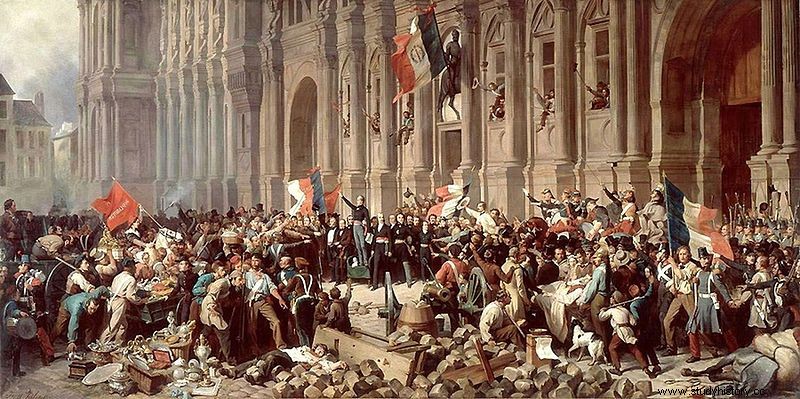- Since 1830, Louis-Philippe has made the July Monarchy a liberal regime based on the Charter, an almost constitutional text.
- In 18 years of reign, France made a commercial leap:railway networks and banks developed, industry modernized, leading to the rise of the bourgeoisie and the impoverishment of workers.
- Democratic institutions thrive despite a high tax base, rooting the republican ideal in political practice. However, the chamber is divided between two extremes, the republicans for whom the revolution is unfinished, and the legitimists (royalists) for whom Louis-Philippe is an undecided usurper.
- Under the influence of Minister Guizot, Louis-Philippe gradually tried to stem Republican unrest in the Chamber and strengthened his regime. The first years of the government were marked by strong social unrest, the economic crisis and epidemics creating a deleterious climate; while the republican demands grow (in particular in favor of universal suffrage). Guizot's authoritarian and royalist vision prevailed in the 1846 elections, in particular thanks to the right to vote for property tax.
- The Republicans are therefore holding campaign banquets for two years, where they present their subversive program. But the prohibition of a banquet on February 22, 1848 provoked the February Revolution.
February 22 to 24, 1848

Characters
Louis-Philippe d'Orleans
Francois Guizot
Adolphe Thiers
Alphonse de Lamartine
Alexandre Ledru-Rollin
Procedure
On February 22, 1848, the banquet that the Republicans were to hold in Paris was banned, but they called on the people to demonstrate. The mobilization turns into a riot, but the police manage to stem the movement.
However, the National Guard joined the crowd on February 23 and the riots flared up again; the king dismisses his minister Guizot, thinking to calm the crowd, but the soldiers fire on the demonstration in front of the Ministry of Foreign Affairs:there are between 20 and 50 dead.
The movement degenerates and Paris rises; even the recall of Minister Adolphe Thiers did not satisfy the crowd, and on February 24, Louis-Philippe abdicated in favor of his grandson.
But the Republicans invaded the Palais-Bourbon and then the Town Hall.
On February 24, the Republicans, including Lamartine and Ledru-Rollin, proclaim the Second Republic.
Consequences
- The Revolution of February 1848 brought revolutionary fervor to Europe:the Spring of the Peoples.
- The Republic establishes universal male suffrage, abolishes slavery in the colonies and creates national workshops to help workers. Its early days were a success, but in June 1848 the government closed the workshops for fear of a labor movement. Paris is once again covered with barricades, and the popular uprising is put down with violence (1,500 shot).
- The Party of Order wins the majority in the Chamber and adopts reactionary laws against communist movements in the countryside.
- Louis-Napoléon Bonaparte was elected president in December 1848. He staged a coup in 1851 and arrested both republicans and monarchists. The people did not seek to defend the Republic, which had shown itself to be reactionary:November 22, 1852 marked the beginning of the Second Empire.
